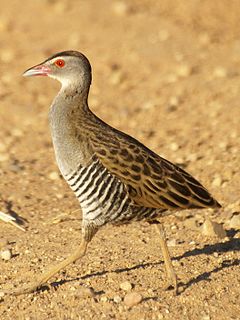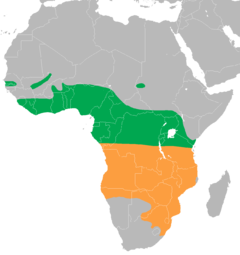African crake
| African crake | |
|---|---|
 |
|
| On the Zaagkuildrift Road, South Africa | |
| Scientific classification | |
| Kingdom: | Animalia |
| Phylum: | Chordata |
| Class: | Aves |
| Order: | Gruiformes |
| Family: | Rallidae |
| Genus: |
Crex Bechstein, 1803 |
| Species: | C. egregia |
| Binomial name | |
|
Crex egregia (Peters, 1854) |
|
 |
|
|
Breeding summer visitor
(ranges are very approximate)Resident year-round |
|
| Synonyms | |
|
Ortygometra egregia |
|
Ortygometra egregia
Crecopsis egregia
Porzana egregia
The African crake (Crex egregia) is a bird in the rail family that breeds in most of sub-Saharan Africa away from the arid south and southwest. It is seasonally common in most of its range other than the rainforests and areas that have low annual rainfall. This crake is a partial migrant, moving away from the equator as soon as the rains provide sufficient grass cover to allow it to breed elsewhere. There have been a few records of vagrant birds reaching Atlantic islands. This species nests in a wide variety of grassland types, and agricultural land with tall crops may also be used.
A smallish crake, the African crake has brown-streaked blackish upperparts, bluish-grey underparts and black-and-white barring on the flanks and belly. It has a stubby red bill, red eyes, and a white line from the bill to above the eye. It is smaller than its closest relative, the corn crake; that species is also lighter-plumaged, and has an eye stripe. The African crake has a range of calls, the most characteristic being a series of rapid grating krrr notes. It is active during the day, and is territorial on both the breeding and non-breeding grounds; the male has a threat display, and may fight at territory boundaries. The nest is a shallow cup of grass leaves built in a depression under a grass tussock or small bush. The 3–11 eggs start hatching after about 14 days, and the black, downy precocial chicks fledge after four to five weeks. The African crake feeds on a wide range of invertebrates, along with some small frogs and fish, and plant material, especially grass seeds. It may itself be eaten by large birds of prey; snakes; or mammals, including humans, and can host parasites. Although it may be displaced temporarily by the burning of grassland, or permanently by agriculture, wetland drainage or urbanisation, its large range and population mean that it is not considered to be threatened.
...
Wikipedia

